David Dubrow's Blog, page 29
October 27, 2016
Game-Changers in Horror Television: The Exorcist and The Walking Dead
It’s been an interesting week for horror fans, what with Episode 5 of The Exorcist and Episode 1, Season 7 of The Walking Dead. Spoilers await below, obviously.
The Exorcist
 The choice to make much of Casey’s attempted exorcism occur off-camera makes sense, because the thrust of the show isn’t the effect of demonic possession on a single family, but a larger demonic plot involving the Pope. This, of course, takes us further away from the text that “inspired” the show. Unlike Merrin and Karras, Tomas and Marcus are ruled by their fundamental weaknesses, and the events of the show bear this out. Tomas can’t keep his libido in check, making him subject to the demon’s glamours, and when he’s thrown out of the padded exorcism chamber the first place he goes is to his crush’s bed. It’s a different way to go than the expected route of making him a homosexual pedophile the way most Catholic priests are portrayed. Marcus can’t control his violent impulses, and despite the SNEC training he got in the previous episode, devolves to hitting Casey across the face in a fit of pique. Perhaps he forgot that Casey’s not in control of her body. In any event, it was gratuitous and cruel. I know that at the end of the movie version, Karras struck Regan and began to choke her, but consider the situation: Merrin had just died and Karras was at the end of his rope. His purpose was to make the demon think he would kill her, and that the only way out was to possess him instead. Hence, “Come into me” and the fatal leap out of the window.
The choice to make much of Casey’s attempted exorcism occur off-camera makes sense, because the thrust of the show isn’t the effect of demonic possession on a single family, but a larger demonic plot involving the Pope. This, of course, takes us further away from the text that “inspired” the show. Unlike Merrin and Karras, Tomas and Marcus are ruled by their fundamental weaknesses, and the events of the show bear this out. Tomas can’t keep his libido in check, making him subject to the demon’s glamours, and when he’s thrown out of the padded exorcism chamber the first place he goes is to his crush’s bed. It’s a different way to go than the expected route of making him a homosexual pedophile the way most Catholic priests are portrayed. Marcus can’t control his violent impulses, and despite the SNEC training he got in the previous episode, devolves to hitting Casey across the face in a fit of pique. Perhaps he forgot that Casey’s not in control of her body. In any event, it was gratuitous and cruel. I know that at the end of the movie version, Karras struck Regan and began to choke her, but consider the situation: Merrin had just died and Karras was at the end of his rope. His purpose was to make the demon think he would kill her, and that the only way out was to possess him instead. Hence, “Come into me” and the fatal leap out of the window.
The news that Angela Rance is a grown-up Regan MacNeil was, I’m certain, supposed to be a game-changer for the show, but when you look at where the show’s been going you’ll find that it doesn’t alter anything. There are still multiple demonic possessions going on, orchestrated by someone we don’t know, and the overarching plot of the Pope’s visit to Chicago is still primary. This attempt to connect the show with the original material seems like a Hail Mary pass (so to speak), something to keep you watching for the remembered thrill of the book or movie. How is Angela’s secret identity going to change that?
The Walking Dead
 I had the episode spoiled for me days before I watched it, but I’m not bitter: many of my social media buddies are horror fans, and people can’t help but talk about things like that. For me, the episode was an unrelieved, 42-minute-long exercise in brutality, with crying and sobbing thrown in to season the stew. Kind of like one of the Hostel movies. I liked Glenn’s popeye and the scrap of scalp hanging from the baseball bat: nice touches.
I had the episode spoiled for me days before I watched it, but I’m not bitter: many of my social media buddies are horror fans, and people can’t help but talk about things like that. For me, the episode was an unrelieved, 42-minute-long exercise in brutality, with crying and sobbing thrown in to season the stew. Kind of like one of the Hostel movies. I liked Glenn’s popeye and the scrap of scalp hanging from the baseball bat: nice touches.
As bad as I felt for Rick’s crew, I felt worse for Negan’s army. I mean, they had to stand there watching Negan talk and talk and yak yak yak for what probably felt like hours, when what they should’ve done was just kill everyone and move on. There weren’t that many of Rick’s crew left, and they couldn’t escape an ambush to save their lives, literally, so what’s the point of keeping them around? Do they have special scavenging powers nobody else has? And they did murder a bunch of Negan’s crew. Now that Negan beat two of them to death in as cruel a fashion as possible, are the rest of them just going to roll over and be good doggies? No. Once they stop being scared, they’re going to start hating and plotting. And then more of your buddies are going to die. Best off killing them and saving yourself the later trouble.
But if they did, there wouldn’t be a show. Kind of a lame way to keep a show going, but I understand it. Abraham had to die because his character was going nowhere. Glenn had to die because we’d all gotten used to the idea of him dying a few episodes ago under the dumpster anyway. And of course they couldn’t kill Daryl, otherwise 50% of the audience would stop watching right there and then (you know who you are, ladies).
This one was a game-changer. Now Rick’s crew has to work for somebody else. We’ll see how long that lasts. Also, said in a Mr Ed voice, Where’s Carol?







October 24, 2016
Book Review: The Seamless Web by Joe Eliseon
 Joe Eliseon’s novel The Seamless Web: A Legal Comedy, is fun to read, filled with memorable characters, and rather longer than it has to be, suffering under the weight of a subplot that doesn’t mesh with the main story. Eliseon’s knowledge of the subject matter makes this a believable tale despite its absurdity, and he doesn’t shy away from the implications of the “legapocalypse” the events of the story might create.
Joe Eliseon’s novel The Seamless Web: A Legal Comedy, is fun to read, filled with memorable characters, and rather longer than it has to be, suffering under the weight of a subplot that doesn’t mesh with the main story. Eliseon’s knowledge of the subject matter makes this a believable tale despite its absurdity, and he doesn’t shy away from the implications of the “legapocalypse” the events of the story might create.
The protagonist, Pete Roselli, is in his own way a cipher, an empty figure that things happen to. After a freak accident enables him to digitally create case law and hence establish legal precedent, he only uses this newfound skill as a means of surviving day-to-day at the cutthroat Park Avenue legal firm where he works. A passive dreamer rather than a go-getter, he’s more comfortable refusing to act than seizing opportunity, which makes him somewhat frustrating; he is the near-literal definition of hapless.
The mechanism through which Pete is able to cheat the legal system requires the novel to be set in the 1980’s, which dates it somewhat and leaves the reader without much to hang onto; so much of the story takes place in offices, courtrooms, and private clubs that it leaves out a sense of the period.
Despite that, the bizarre characters you meet along the way more than make up for the novel’s shortcomings and make the fundamentally weak, pushover character of Peter seem rock-solid in comparison. From Keneally the crazy Vietnam veteran attorney to fortune cookie vendor Tommy Lao to Pete’s boss, the eternally irascible Jack Berman, they’re all hysterically funny and unforgettable.
Even if legal comedies aren’t your thing (they weren’t before I read this book), The Seamless Web is definitely worth your time.







October 20, 2016
New Review of The Ultimate Guide to Surviving a Zombie Apocalypse
 Jason at The Mad Ravings of an Entertainment Junkie reviewed The Ultimate Guide to Surviving a Zombie Apocalypse:
Jason at The Mad Ravings of an Entertainment Junkie reviewed The Ultimate Guide to Surviving a Zombie Apocalypse:
Written by F. Kim O’Neill (not much is known about him, although he must have an impressive background) this book covers everything that you can think of, and I mean EVERYTHING!
Mr. O’Neill does indeed have an impressive background, but he’s also quite the man of mystery. Click to read the entire review!







The Exorcist: S1 E4 Review
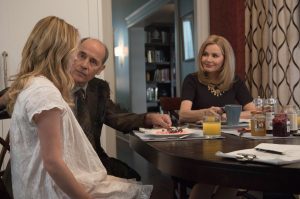 As the show moves on, it’s clear that the producers have decided to use the name of William Peter Blatty’s story to tell a completely different story, one that has only the most tenuous connection to the subject matter.
As the show moves on, it’s clear that the producers have decided to use the name of William Peter Blatty’s story to tell a completely different story, one that has only the most tenuous connection to the subject matter.
In the unnecessary dream sequence at the beginning of the episode, the demon inside Casey demands that she give in. What does capitulation to the demon mean? What does it look like? Did the guy who the nuns were trying to exorcize give in?
So far, the most solid parts of the show are Alfonso Herrera as Tomas and Geena Davis as Angela; their performances remain believable and human except in one instance: Tomas and Jessica. The two actors just don’t seem to have much chemistry between them, making the temptation angle seem like a stretch. Despite the letters, Jessica staying at his apartment, I didn’t get that sense of longing, of unrequited attraction. It’s no doubt going to be an issue as part of Casey’s exorcism, but it feels rote, shoehorned in.
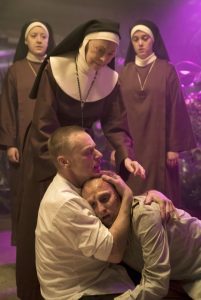 The comic relief of the Movable Deceased couple was a little jarring, but the later conversation with Marcus in the trailer revealed a lot when it comes to the show’s theme. When Cherry Rego says to Marcus, “A priest with a gun,” Marcus comes back with, “An exorcist with a gun.” Lacking context, this might be a veiled reference to Marcus’s excommunication, but that’s not the case here: the show is creating a distinct difference between the role of a priest and the role of an exorcist, and it’s only because Marcus has left the clergy of the Catholic Church that he can answer his true calling as an exorcist. He’s no Father Karras, let alone a Father Merrin. He’s not even a priest anymore, but that’s a good thing, because the Catholic Church is “compromised,” a fact confirmed by the Abbess.
The comic relief of the Movable Deceased couple was a little jarring, but the later conversation with Marcus in the trailer revealed a lot when it comes to the show’s theme. When Cherry Rego says to Marcus, “A priest with a gun,” Marcus comes back with, “An exorcist with a gun.” Lacking context, this might be a veiled reference to Marcus’s excommunication, but that’s not the case here: the show is creating a distinct difference between the role of a priest and the role of an exorcist, and it’s only because Marcus has left the clergy of the Catholic Church that he can answer his true calling as an exorcist. He’s no Father Karras, let alone a Father Merrin. He’s not even a priest anymore, but that’s a good thing, because the Catholic Church is “compromised,” a fact confirmed by the Abbess.
Where the show lost me was the Secret Nuns Exorcism Club (SNEC), particularly when the Abbess says of priests, “You coerce and compel. We [nuns] use compassion, forgiveness, and patience.” Compassion. Against a demon. It makes no sense, and reminded me of a particular presidential candidate’s risible quote, “Showing respect even for ones enemies….Trying to understand and in so far as psychologically possible, empathize with their perspective and point of view.” I thought demons were evil. Not misunderstood and in need of compassion and forgiveness, but evil through and through. Apparently not.
Are they going to call in the SNEC in Episode 5, when things get rough with Casey Rance? Will Marcus just give Casey a big hug and show her the love she so desperately needs?







October 19, 2016
The Loftus Party: Getting Along Is Not Going Along
 I’ve been invited to contribute to the Loftus Party, a culture and politics website. It’s the brainchild of writer and comedian , and focuses on commentary that’s more right of center than left-wing. My first piece discusses debating bad ideas, not bad people:
I’ve been invited to contribute to the Loftus Party, a culture and politics website. It’s the brainchild of writer and comedian , and focuses on commentary that’s more right of center than left-wing. My first piece discusses debating bad ideas, not bad people:
And yet I have leftist friends. Leftist relatives. Leftist cyber-buddies, even. You probably do, too.
How do I get along with them?
By recognizing a simple fact: the sum total of a person is far, far greater than his political beliefs. It’s a notion we used to take for granted, but it needs to be stated clearly and for the record.
Click to read the whole piece. It describes a philosophy that’s desperately needed in today’s polarized cultural climate.







October 13, 2016
The Exorcist: S1 E3 Review
 Episode 2 made it clear that Fox’s The Exorcist is a television show at war with itself: its protagonists are Catholics, but it demonstrates animus toward the Catholic Church. The theme has been carried over into Episode 3, making it central to the story. Spoilers await below.
Episode 2 made it clear that Fox’s The Exorcist is a television show at war with itself: its protagonists are Catholics, but it demonstrates animus toward the Catholic Church. The theme has been carried over into Episode 3, making it central to the story. Spoilers await below.
This episode was in large part about Father Marcus, which is a problem because the character is entirely unlikable. In an early scene, Marcus shows his disrespect for Father Tomas’s church by eating corn on the cob in the pews. Later, when the Rance family has him look at Casey’s bedroom, he rifles through her belongings like a narcotics cop with a search warrant, treating the Rances with the same contempt that he showed the church. In his interview with Casey he demonstrates absolutely no compassion for her, conducting a Hannibal Lecter-like examination of her psyche. I understand that his intent was to provoke the demon inside of her, but wouldn’t it have made things more interesting if he had shown some measure of regret or disgust at what he had to do to make the demon manifest? The intensity of the scene was undercut by the unintentionally hilarious line, “Give me some sign of your presence,” while pictures are dropping to the ground and papers are flying in a telekinetic wind (compare it to this scene from The Man With Two Brains). Was the later scene of Marcus telling the stained glass image of Jesus Christ to “shut up” supposed to be shocking? It seemed like the sort of thing he does every day.
Don’t worry about his excommunication, though: it’s a good thing. The Catholic Church may be “compromised,” according to Father Bennett, so Marcus is now free to engage in exorcism without all those church people getting in his grill and messing up his style. Beats having to follow rules that he didn’t respect anyway.
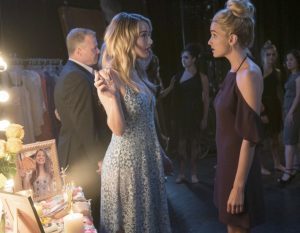 Sibling rivalry was the other big theme of this episode, though it’s hard to take it seriously when the show has given us so little reason to care about what happens to Casey or Kat. Casey’s change from nice girl to malicious possessed doesn’t work: we didn’t see her enough in the beginning for the transformation to evoke much pathos. Between her breaking the other girl’s leg in the previous episode and going completely crazy on the train molester in this episode, she comes off more like Carrie than an innocent girl possessed by a horrible demon. (For a laugh, check out this IMDB thread: the subway scene had the desired “You go girl!” effect on a certain segment of viewership.) If the demon isn’t there to degrade Casey, to make her do and say things that humiliate and disgust her and turn her away from God, then why is the demon possessing her? So far, the demon seems content to give Casey superpowers and make her masturbate with curling irons.
Sibling rivalry was the other big theme of this episode, though it’s hard to take it seriously when the show has given us so little reason to care about what happens to Casey or Kat. Casey’s change from nice girl to malicious possessed doesn’t work: we didn’t see her enough in the beginning for the transformation to evoke much pathos. Between her breaking the other girl’s leg in the previous episode and going completely crazy on the train molester in this episode, she comes off more like Carrie than an innocent girl possessed by a horrible demon. (For a laugh, check out this IMDB thread: the subway scene had the desired “You go girl!” effect on a certain segment of viewership.) If the demon isn’t there to degrade Casey, to make her do and say things that humiliate and disgust her and turn her away from God, then why is the demon possessing her? So far, the demon seems content to give Casey superpowers and make her masturbate with curling irons.
If nothing else, Fox’s The Exorcist is a perfect example of the current style of Hollywood storytelling. It attempts to create empathy for Kat by making her a lesbian; it gives obligatory nods to class warfare in the Father Tomas vs. the Catholic Church lunch scene (of course the French-speaking bishop thinks Tomas is on the right track because Europeans are more enlightened); and it casts organized religion in (almost) as negative light as a television show about Catholics can get away with.
Who’s summoning all the demons, anyway? A rogue exorcist? The Pope? Anything goes, it seems.







October 11, 2016
The Slaughtered Bird Book Review: Stiff Things: The Splatterporn Anthology
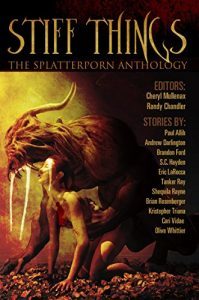 At The Slaughtered Bird, I reviewed Stiff Things: The Splatterporn Anthology:
At The Slaughtered Bird, I reviewed Stiff Things: The Splatterporn Anthology:
Obviously, the point of splatterporn is to elicit repugnance, and this anthology is wildly successful at that. Where else can you read about rape, genital mutilation, necrophilia, and the spraying of semen, vaginal juice, and blood without being denounced as a social undesirable? Is that even possible anymore? The being socially undesirable thing, not the being denounced thing.
Click to read the rest of the review. Stiff Things might just be your cup of…of tea!







October 5, 2016
The Exorcist: S1 E2 Review
 This episode was more focused than the first, though what it showed us doesn’t bode well, thematically speaking. We’re moving away from the source material and heading toward tired, well-trodden ground. Spoilers await below.
This episode was more focused than the first, though what it showed us doesn’t bode well, thematically speaking. We’re moving away from the source material and heading toward tired, well-trodden ground. Spoilers await below.
In the film version of The Exorcist, the Catholic Church was a force for good. Brendan Stewart says of it, “Even more unusual for a horror film, or any film made after the 1950s, is that the good is represented unambiguously by the Catholic Church. There’s no ironic detachment, no Christian bashing.” This is clearly not the case in the television show. The unappealing papal ambassador describes the Pope thusly, when arranging for his arrival: “Poverty, humility, be nicer to the gays.” Why the last part? It’s a nudge-nudge wink-wink to the audience to tell us that we all know that the Catholic Church is super mean to the gays, you guys. Catholics are, according to TV’s The Exorcist, homophobes.
Not only are Catholics homophobes, but they also buy children from foster homes to be used as exorcists in training, according to Father Marcus’s story. So they’re slavers, too. If an exorcism is such a horrible, grueling, risky experience for both priest and possessed, why have a child attempt it alone, in a dark basement? It made no sense.
 Father Marcus says of the Bible, “Most of the words in here are man’s words, not God’s.” This gets to the heart of the problem with the show: they’re secularizing the source material. Which parts, exactly, are God’s words, then? And why didn’t those words work on the possessed homeless lady on the street? Which Biblical scholar in the production crew decided the difference between man’s and God’s words?
Father Marcus says of the Bible, “Most of the words in here are man’s words, not God’s.” This gets to the heart of the problem with the show: they’re secularizing the source material. Which parts, exactly, are God’s words, then? And why didn’t those words work on the possessed homeless lady on the street? Which Biblical scholar in the production crew decided the difference between man’s and God’s words?
Talking about differences, what’s the difference between Father Marcus and Dean Winchester of Supernatural? Both have been trained since childhood to fight demons, and have literally nothing else in their lives. Both talk about demons in combative terms, using devices like holy water and crosses as weapons. When Marcus tells Tomas to break it off with Jessica, he doesn’t couch it in terms of saving his soul or upholding his priestly vows, but because it might make him vulnerable in combat with a demon. Marcus isn’t a priest, but a hunter, and we’ve seen that show before.
Father Marcus is a Catholic priest. Father Tomas is a Catholic priest. The Rance family is Catholic. But the show has an obvious animus toward the Catholic Church. It’s a stupid, unnecessary conflict that reflects the Hollywood mindset, not adherence to the subject matter.
I liked the schizos with the coolers walking into the Tattersall truck; and it’s clear that the demons are massing because of the Pope’s imminent arrival. Why don’t the posters advertising the Pope’s visit show the Supreme Pontiff’s face? I’d hate to think that the avuncular-yet-sinister externalization of the demon in Casey is being set up as the Pope, but who knows?
One question: If Casey is sickened by drinking holy water, how is it that she can stand being inside a church?







October 3, 2016
Let’s Bring Objective Morality Back to Horror
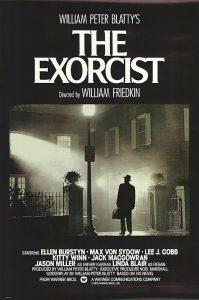 On the terrific website Scifi and Scary, I wrote a guest post on God and supernatural horror:
On the terrific website Scifi and Scary, I wrote a guest post on God and supernatural horror:
Supernatural horror has turned away from its roots, replacing the traditional battle of Good vs. Evil with Us vs. Evil. In large part this is reflective of cultural trends; mainstream writers and movie makers tend to take their thematic cues from the less-religious metropolitan areas of the East and West Coasts, which drive culture more than flyover country. The replacement of an objective power of Good with expedience, the need to survive, has dulled the effectiveness of the genre of supernatural horror, reducing vampires to fanged superhumans and Hell-born demons to savage mutants.
Read the rest at Scifi and Scary!







September 30, 2016
Book Review: The Final Cut by Jasper Bark
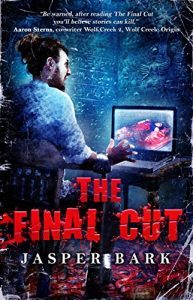 Jasper Bark’s novel The Final Cut is the literary equivalent of a pitcher plant: once you fall in, you never come out again. At least, not unchanged.
Jasper Bark’s novel The Final Cut is the literary equivalent of a pitcher plant: once you fall in, you never come out again. At least, not unchanged.
When writing book reviews, it’s easy to slide into hyperbole and cliché: “This is the best book I’ve ever read!” Or, “Spine-tingling, horrific!” The reality, however, never quite matches up with the hype, does it?
Not until now.
Intricately plotted, The Final Cut takes you deeper and deeper, page by page, into a story that’s unbelievably dark, but not without Bark’s inimitable touches of black humor. Sam’s experiences in particular are horrific when read in the moment, but laughed at in recollection. Despite this darkness, Bark’s purpose is not to elicit disgust for its own sake, but to tell a broader story of why we read horror, why we subject ourselves to vicarious suffering.
That’s what makes this such a compelling, even necessary book. It’s a master class on horror for both reader and writer, getting under your skin and, most importantly, staying there. The ending…I wish I could tell you about it, how you won’t forget it, how deeply disturbing it is, but I can’t say too much or I’ll ruin the surprise. It “plagues your mind” because of how it ends, not that it doesn’t: a rare feat in horror literature.
I’ve mentioned before how Bark “uses horror tropes as a pulley, of sorts, to move the machinery of much larger themes,” and nowhere else is this more evident than in The Final Cut. Here, Bark tackles the central conceit of the horror genre itself, as well as the nature of storytelling. To quote the Tailor of the True Cloth, a character we can all learn from, “Fiction isn’t real life…when you tell a story you are setting a contract with your audience.” Bark is telling us here that readers have a right to demand quality from the stories they read, and that writers have an obligation to provide that quality. The best stories, Bark says, are those that end: “A story without an ending lacks the proper shape or form, it insults the audience and plagues their mind because it lacks resolution.”
Part horror, part fantasy, all extraordinary, The Final Cut is a book you’ll find impossible to disregard. It sinks hooks in you from the first page and never, ever lets go, not even when you’ve closed the book.










